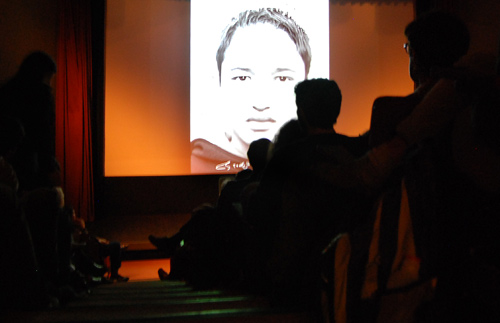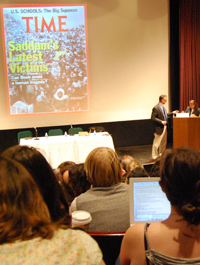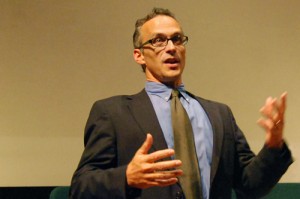Photographers Speak on ‘Eye of History: The Camera as Witness’ Panel

“We can never really claim to have seen anything unless it has been photographed.” — Émile Zola, c. 1901, Minutes of the Camera Club of Paris
Documentary photographers, contemporary visual artists and historians grapple with issues of photographic meaning, evidence, and interpretation.
This fall, Wesleyan has hosted a series of exhibitions, talks and films that explore photography’s role in historiography, historical memory and public life. Organized by Associate Professor of History Jennifer Tucker, “Eye of History: The Camera as Witness” serves as a meeting point for people who share a common interest in photography, art and historical memory.
On Nov. 7, internationally-renowned documentary photographers Wendy Ewald, Eric Gottesman and Susan Meiselas joined acclaimed writer and critic David Levi Strauss in a panel discussion about photography’s role in the world today.
Ewald, Gottesman, and Meiselas took turns describe their recent photographic works with accompanying slide shows, and joined Strauss in a wide-ranging conversation about topics such as photographic practice, art and historical memory.

Meiselas showed how she traced the history of the Kurds through a collection of photographs, letters, memoirs, government reports and narratives in her book, Kurdistan: In the Shadow of History.
“I wanted to show the history of interpretation, not the history, of the Kurds over the past 100 years,” said Meiselas, an award-winning documentary photographer best known for her work photographing the Nicaraguan Revolution in 1978-79.
Ewald described how she used photography between 2004-06 to help refugee children talk about their life and future hopes. She used portraits, quotations and recordings to tell their stories, and shared samples of her work during the presentation.
A public question and answer session followed the presentations and panel. All members of the audience were invited to a reception and viewing of the exhibition “Framing and Being Framed: The Uses of Documentary Photography” at Ezra and Cecile Zilkha Gallery. Nina Felshin, curator of the the Zilkha Gallery, organized the panel.

Along with “Framing and Being Framed: The Uses of Documentary Photography,” which is on exhibit until Dec 7., upcoming “Eye of History” events include: “The Photograph and the Book,” on exhibit in Olin Library through Jan. 15; “Document or Art? Photography in the Long 19th Century, 1839–1914,” on exhibit through Dec. 7; and the film, Why We Fight: War Comes to America (1945) will be shown in the Center for Film Studies’ Powell Family Screening Room at 7 p.m. Nov. 18.
Also, as part of “Eye of History,” Wesleyan’s Green Street Arts Center provides a monthly forum for photographers and photo enthusiasts to share work, tips, questions and opportunities in a new series titled “Flash Forward.” In January, Green Street will host an exhibition of “Eye of History” images created over the course of the fall. The next Flash Forward meeting is Dec. 9 at the GSAC.
“In the end, what are these (photographs) really,” asks Meiselas. “They belong to the community. It’s a family album in the end.”
“Eye of History: The Camera as a Witness” is co-sponsored by The Allbritton Center for the Study of Public Life, The Center for the Arts, The Center for the Humanities, History and Theory, and the Ezra and Cecile Zilkha Gallery.
For more information, visit the Eye of History website.

